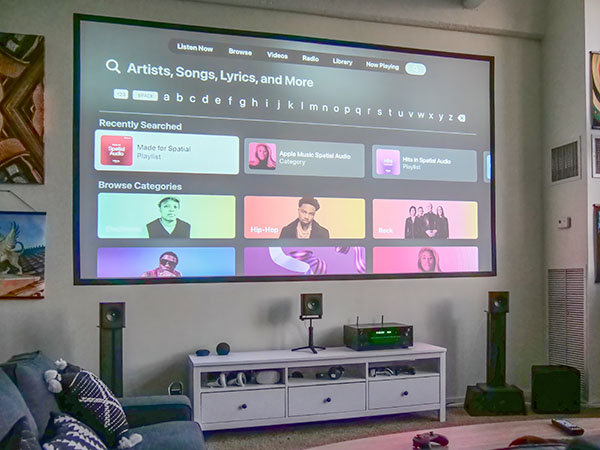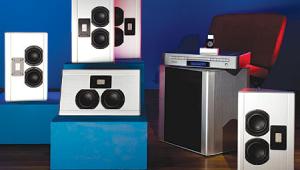Monolith M518HT 5.1 THX Sub/Satellite System Review Page 2
My favorite thing about this speaker system is that it is a highly competent 5.1 surround system—and that's great—but it even holds up as a 2.1 system. Listen to stereo music through just the front left and right pair of satellites, with the sub taking care of the bass, and you are treated to a sophisticated presentation, dynamics, nuanced and detailed like you'd expect from quality larger speakers.
If my listening was performed in a different context, let's say this was a high-end audio show, somebody would talk up the audiophile-friendly qualities of a small, dense enclosure and point source driver array with reverence. But it is a 5.1 HTiB connected to an AVR, and dogma says such a system must not be considered audiophile! Lol.
The hints that these speakers aspire to more than HTiB status are right there in the specs, especially the low 81 dB sensitivity and the 4 ohm impedance. With their surprising bass extension and overall flat response, they integrate really well with the included subwoofer, with a 100 Hz crossover working out as ideal. Yes the satellites play down to 80 Hz before response drops off, but you want some overlap with the flat part of the curve for a good transition, which is why I wound up settling on 100 Hz. I also noticed that at higher volumes and with the 100 Hz crossover, cone movement was reduced versus the 80 Hz setting. Translation: Going with 100 Hz sounds a bit better and it lets you push the entire system a little harder.
If imaging is the main strength of these speakers, dynamics are the weakness. They sound and feel unconstrained at lower output levels. But once you start pushing the volume knob, it's not that they distort or sound bad, it's just that dynamic compression is inevitable given the limited excursion of the mid-woofer driver. You can tell that they are squeezing the material to make it fit, the effect of dynamic compression is that it paradoxically makes the speakers sound smaller (or I should say less capable) when the volume is higher. One thing I quickly concluded is there's little difference between using the big Denon and the more modest Onkyo to run the Monoliths. Except in the rarest of circumstances where all channels are driven to their limit, with either AVR the speakers will start running out of dynamic headroom before the amp clips.
At modest volume levels, with the system nicely dialed in, the satellites are free to do their best work. Their top quality is the classic audiophile speaker disappearing act. Unless anchored to a channel, like center channel dialog, sounds appear to float in thin air. You don't localize the speakers because they are all identical and quite neutral sounding, which makes for seamless sound effect steering. Their best trick is recreating ambience, like a reverb or echo, which gives a sense of space and physical volume. With movies, it means that a cave sounds cave-like and expansive, while the inside of a car is much smaller and highly damped, for a claustrophobic effect. With this system, you hear the character of the different ambiences.
For music evaluation, I spent several fun days with this system playing various favorite albums, often finding the experience engrossing and entertaining thanks to little things, like hearing fine details that sneak through a thick mix. For example the album All Colors by Bassnectar, it's a laid-back electronic bass music masterpiece and without question there's a trademark focus on bass. But the production is exquisite, with plenty of sparkling treble synthesizer sounds to serve as counterpoint to the tangible texture and depth of the bass tones. It's music that demands a system that's highly capable across the entire audio spectrum, top to bottom clarity and I found the Monoliths consistently managed to meet the challenge.
Rocking Beastie Boys The In Sound From Way Out! is always a fun listen, it's from a period of time when the rappers picked up real instruments and became an actual band. The result is a very funky recording, intimate but with high production value. It's got plenty of instrumental solos, so I just sit back and enjoy the unadulterated drumming, pure electric bass, finely played organ, and classic electric guitar sound in numerous styles. There's no pretense, it is cleanly recorded, classic, with a very full sounding mix, and possessing lots of fun little details to latch on to which add up to a convincing illusion that the band is in the room playing. If you pay proper attention, the artistry of the mix comes through, which is remarkable for speakers of this size and price.
Are there any Bill Laswell fans reading? I queued up his 1997 album Chapter Two (issued under the band name Sacred System) and was greeted with that classic, liquid, floaty Laswell sound. This was the piece de resistance of this HTiB's audition. Right from the first track "Thanupa" that starts off with tabla, but opens up into lush drums and dreamy jazzy trumpet, exotic guitar licks, the whole shebang all expertly mixed to create a swirling psychedelic experience. For this, I allowed the AVR to upmix the stereo to Dolby Surround, which created a greater sense of envelopment. The effect does not suit all music, but is very appropriate to Laswell's style and I do use it a lot with studio-produced electronic music.

Upmixing music is one thing, but now with Dolby Atmos music and spatial audio you can have surround-sound that's deliberately mixed for surround. The selection is very limited compared to stereo tracks, but what I know for sure is that listening to even this 5.1 system beats spatial audio through headphones. So, I played some Atmos tracks using an Apple TV 4K as the source and streaming Apple Music to my AVR. First up, "Psycho Killer" by The Talking Heads, which uses Atmos to enhance the soundstage, but is a gimmick-free mix. What's clear is the surrounds get a lot more use in this mix, but also clear are David Byrne's vocals, which sit properly in the mix with the center channel running.
Next up in Atmos music, "Royals" by Lorde, useful for both judging female vocals and the quality of the bass. This is one of those tracks that's mixed to sound huge, so long as the speakers can convey that sensation. The Atmos mix through the Monoliths achieves that sense of grandeur, but at the same time, Lorde's voice is immediate and present, no veils here. The benefit of having a center channel and a mix that deliberately uses it are abundantly clear here.
The lesson I learned from the Atmos mixes is that even with a 5.1 speaker system, the spatial audio versions of various familiar tracks benefit from the added channels. Which is great because this system makes music sound really nice whether it's playing in stereo, upmixed surround, or Atmos spatial audio.
What's life without Grand Theft Auto Online? I have no idea! My favorite video game by far, it's got a hyper-detailed soundscape that's rendered realistically on this system. Crucially, thuds have weighty impact while telltale sounds like gunfire and explosions have the directionality you need to use sound to your advantage, but also to feel like you are in the game because when you turn your characters head, the whole soundfield rotates appropriately, like one giant bubble. That's what you get out of the five good, sonically matched speakers, and the effects run the gamut from distant voices and leaves rustling in the wind, to the intensity of all the engines and the visceral thuds of impacts when racing.
As a Sixers and Eagles fan, I have listened to this system handle numerous sports broadcasts and always find the announcers' voices to be crystal clear. That dialog clarity carries over to shows and movies, too.
For movies, I checked out scenes from Top Gun: Maverick, Bullet Train, Black Adam, Nope, and Elvis. Each exceeded my expectations for a 5.1 compact system for creating a sense of envelopment, but even with complex action, the dialog clarity was notable. It is a matter of fact that for clarity, a 2-way concentric speaker is a great design for a center channel. But like the rest of the satellites, the significant limitation of the center channel is output, and it is in action movies that the use of the satellite butts heads with the demands movies make of that center channel. Simply put, with some movies, inevitably the center is going to run out of headroom first—but not before it outperforms what you've heard come from a soundbar.
Subjectively speaking, I find these satellites deliver great sound for the money, when operating within their power handling limits. That's the key here, within their limits. Out of curiosity, I ran some nearfield measurements on one of the satellites, placing it in the center of my room on a 6-foot stand. I used test tones generated by Room EQ Wizard, measured with a miniDSP UMIK-2. It's nothing scientific, just seeing how some on-axis and off-axis measurements compare to Audyssey. Survey says… these speakers do what they say they do in terms of frequency response, I've seen much pricier speakers measure quite a bit worse (bass extension notwithstanding).
From one foot away the speaker's measurements look phenomenal. That's because the room is interfering very little. The most ideal response appears to be in the 20 to 30 degrees off axis range, but it's nearly identical to on on-axis. 60 degrees off axis sees output drop a couple of dB overall, and introduces a roll-off above 10 kHz, but even from that angle the response remains highly linear. Measurements taken from one meter away are essentially the same, aside from a bumpier graph caused by room interference.
I followed the speaker measurements with some of the sub in each of its three EQ modes. There's nothing there to contradict the specifications, it truly is about how you want to balance output versus extension. Ultimately this is an 8-inch sub, so it's not going to perform miracles and play 16 Hz infrasonics that rattle foundations. But it's without a doubt a really good 8-inch sub for the money and a major factor in why this whole system sounds as good as it does.
Conclusion
At this point Monolith by Monoprice has proven it is a force to be reckoned with. This speaker system continues a winning streak of product introductions that offer a high bang for the buck ratio. The sound quality Monolith squeezed out of this system is so good, it causes cognitive dissonance; I keep thinking "it can't really be sounding this good, can it? It's just a home theater in a box." It is remarkable that the satellites measure as good as they do, and that translates directly into good sound. While I only reviewed a 5.1 configuration, it's easy to extrapolate and see how two of these packages would create a formidable 5.2.4 Atmos speaker system, one that'll easily fit into a smaller space.
I never thought I'd love the sound of a home theater in a box speaker system, but it's impossible to deny that this Monolith offering raises the bar for the category. It's by no means the right solution for every application, but when you consider how many features you get with today's AVRs—plenty of inputs, wireless connectivity, room correction, Atmos and DTS:X—there's a lot to be said for the overall value. That's why as a premium alternative to a soundbar, an AVR plus this speaker system is a great option. In situations where the size and form factor and price are appropriate to the application, it's an obvious bargain and a Top Value.
- Log in or register to post comments





























































